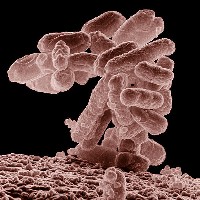Researchers at University of Nottingham in the U.K. and Massachusetts Institute of Technology identified a new class of polymer materials that resist the attachment of bacterial pathogens. The team headed by Nottingham’s Morgan Alexander appears online in the journal Nature Biotechnology (paid subscription required).
According to the university, infections related to medical devices, caused by bacteria attached the the devices, cost the U.K.’s National Health Service some £1 billion ($US 1.57 billion) a year. The Centers for Disease Control and Prevention in the U.S. says the most common device-related infections — central line-associated bloodstream infections, catheter-associated urinary tract infections, and ventilator-associated pneumonia — account for about two-thirds of all health care-associated infections. The bacteria form into collections on the devices called biofilms that are difficult to control and remove.
Alexander’s team from Nottingham’s pharmacy and molecular medical sciences departments used high-speed computer testing of potential materials’ reactions to bacteria called high-throughput screening, a technology developed for the pharmaceutical and biotechnology industries. With help from chemical engineering colleagues at MIT, the Nottingham team screened thousands of polymer materials, testing the chemistry of those materials against bacterial pathogens. Current materials testing techniques, say the researchers, could not have performed this task.
The Nottingham team, says Alexander, “discovered a new group of structurally related materials that dramatically reduce the attachment of pathogenic bacteria — Pseudomonas aeruginosa, Staphylococcus aureus and Escherichia coli.” The researchers coated the hydrocarbon-based polymers identified through the screening process on silicone, similar to the material used in many medical devices.
The in vitro lab tests showed the silicone coated with the identified polymers achieved reductions of some 97 percent in the surface area covered by bacteria compared with a commercial silver hydrogel coating. The researchers then tested coated silicone implants in mice, and found the implants also resisted the attachment of bacteria and formation of biofilms.
The next stage of this research, says Nottingham, is to develop a manufacturing process for these polymer coatings to test their performance clinically. The university says the technology’s developers are in early stage discussions with a number of medical device companies.
The following video tells more about the research.
- Liquid Coating Prevents Biofilm Build-Up on Surfaces
- Selenium Found to Control Staph Bacteria on Implant Material
- Nanotech Composites Aid Tooth Cavity Repair
- New Process Discovered for Fighting Contact Lens Bacteria
* * *


 RSS - Posts
RSS - Posts
[…] Polymer Materials Discovered That Resist Bacteria Attachment […]